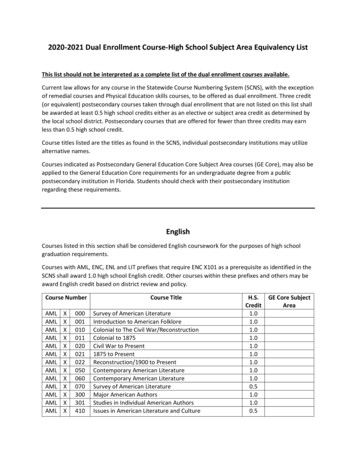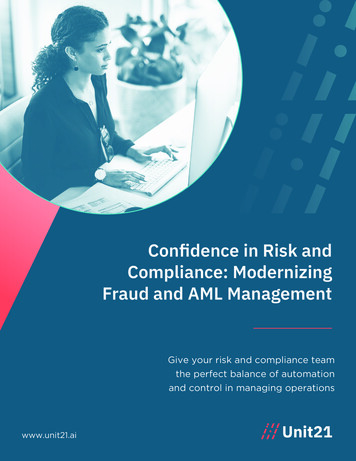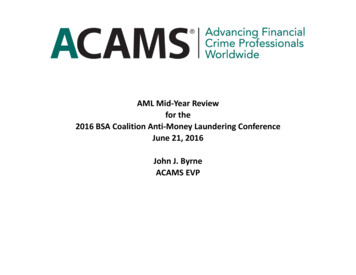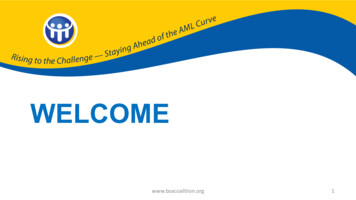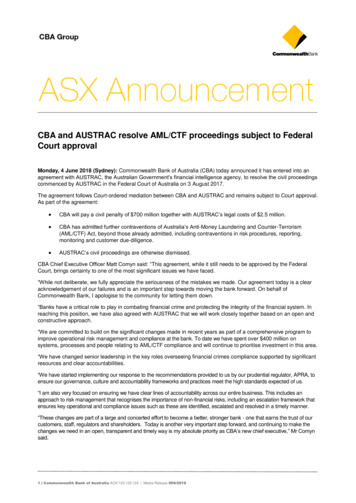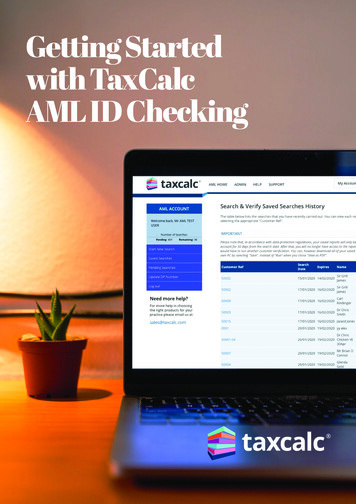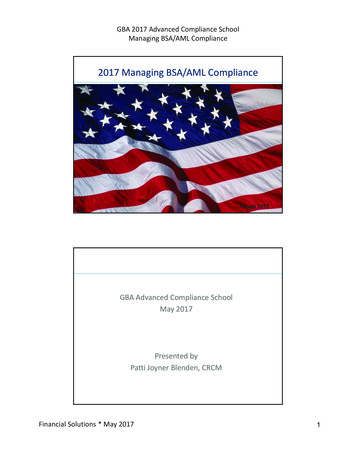
Transcription
GBA 2017 Advanced Compliance SchoolManaging BSA/AML Compliance2017 Managing BSA/AML ComplianceAugust 2015GBA Advanced Compliance SchoolMay 2017Presented byPatti Joyner Blenden, CRCMFinancial Solutions * May 20171
GBA 2017 Advanced Compliance SchoolManaging BSA/AML ComplianceBirth of the Bank Secrecy Act (BSA)Enacted in 1970‐ The law requires financial institutions toassist government agencies in efforts to curbfederal crime by imposing recordkeeping andreporting requirements.– Since the passage of the BSA, the nature and frequency of money‐laundering crimes, especially those related to illegal drugtrafficking, have increased and changed considerably.3Significant BSA Milestones 1986 ‐ Money laundering was made a crime. Congress alsoallowed the seizure and forfeiture of laundered funds. Bankswere required to have a formal BSA compliance program. 1990 ‐ Financial Crimes Enforcement Network (FinCEN) wascreated to administer BSA.4Financial Solutions * May 20172
GBA 2017 Advanced Compliance SchoolManaging BSA/AML ComplianceSignificant BSA Milestones (continued) 1995 ‐ Record keeping requirements for funds transfers, suchas wire transfers, were added and Currency TransactionExemptions introduced. 2001 ‐ The role of the banking system in assisting lawenforcement changed again with Congress enacted theUSA PATRIOT Act:Uniting and Strengthening America by Providing AppropriateTools Required to Intercept and Obstruct Terrorism Act5Regulating BSA and USA PATRIOT Act In 2005 the federal banking agenciesjointly issued a comprehensiveinteragency examination manual coveringthe BSA, Anti‐Money Laundering (AML)laws and Office of Foreign Assets Control(OFAC) regulations:Revised in 2007, 2010and most recently in2014.– Bank Secrecy Act / Anti‐MoneyLaundering Examination Manual,Federal Financial InstitutionsExamination Council (FFIEC)6Financial Solutions * May 20173
GBA 2017 Advanced Compliance SchoolManaging BSA/AML ComplianceNew FFIEC BSA/AML Examination Manual On December 2, 2014, the FFIECreleased an updated version of theBank Secrecy Act/Anti‐MoneyLaundering Examination Manual(November 2014), replacing the priorApril 2010 version. The bank regulatory agenciesannounced the updated manual,assuring bankers the changes werenot changes to regulatory policies orprocedures. Instead, the changeswere designed to reflect newregulations, advisories and otherguidance that has been issued afterpublishing the April 2010 manual.7Significant Changes to the BSA/AML Exam Manual Independent TestingSuspicious Activity Reporting (SAR)Currency Transaction Report (CTR)Foreign Correspondent Account RecordkeepingForeign Bank and Financial Accounts (FBAR)International Transportation of Currency or MonetaryInstruments Reporting (CMIR) ACH, Prepaid Access & Third Party Payment Processors Nonbank Financial Institutions (NBFIs) – MoneyServices Businesses (MSB)8Financial Solutions * May 20174
GBA 2017 Advanced Compliance SchoolManaging BSA/AML ComplianceFinCEN Advisory on Compliance CultureAdvisory to U.S.Financial Institutionson Promoting aCulture of ComplianceA financial institution can strengthen its BSA/AML compliance culture byensuring that:(1) Its leadership actively supports and understands compliance efforts;(2) Efforts to manage and mitigate BSA/AML deficiencies and risks are not compromised by revenueinterests;(3) Relevant information from the various departments within the organization is shared withcompliance staff to further BSA/AML efforts;(4) The institution devotes adequate resources to its compliance function;(5) The compliance program is effective by, among other things ensuring that it is tested by anindependent and competent party; and(6) Its leadership and staff understand the purpose of its BSA/AML efforts and how its reporting isused.9What's Required in a BSA/AML ProgramBSA Program Requirements:1. Must be reduced to writing2. Approved by board of directors3. Should be based on the institution’s riskassessment, as periodically updated. Riskassessments should be determined by theinstitutions:–––Products and servicesCustomers and entitiesGeographies served10Financial Solutions * May 20175
GBA 2017 Advanced Compliance SchoolManaging BSA/AML ComplianceFive Pillars of a BSA Compliance ProgramBSA ustomerDueDiligenceBSA/AML Compliance Program11BSA / AML Program Pillar (1 of 5)Appointing BSA Officer – Designated by Board ofDirectors (BOD).– Must have sufficientauthority.– Manage all aspects ofBSA/AML program.– Ability to communicatewith BOD.12Financial Solutions * May 20176
GBA 2017 Advanced Compliance SchoolManaging BSA/AML ComplianceBSA / AML Program Pillar (2 of 5)BSA/AML Training– Provide training to allpersonnel whose dutiesrequire knowledge ofBSA (Including BOD).– Tailored for personsresponsibilities.– New hire and on‐goingtraining.– Document dates andattendance.13BSA / AML Program Pillar (3 of 5)Internal Controls– Implement risk‐basedpolicies, procedures, andprocesses.– Provide sufficientcontrols and monitoringsystems for the timelydetection and reportingof suspicious activity– Identify areas more vulnerableto abuse.– Meet recordkeeping andreporting requirements (e.g.CTRs and SARs).– Sufficient controls toprevent/identify breakdowns.– Incorporate BSA complianceinto job descriptions andevaluations14Financial Solutions * May 20177
GBA 2017 Advanced Compliance SchoolManaging BSA/AML ComplianceBSA / AML Program Pillar (4 of 5)Independent Testing – Conducted by 3rd party(e.g. Auditors,consultants).– Frequency of testcommensurate withBSA/AML risk profile.– Identify areas ofweakness.– Results should bereported to BOD.15BSA / AML Program Pillar (5 of 5)Customer Due Diligence – Must obtain informationregarding ownership ofall new entity customers Beneficial Ownership– CDD information mustbe obtained at accountopening– New beneficialownership rule made itmandatory in the regs toupdate CDD information16Financial Solutions * May 20178
GBA 2017 Advanced Compliance SchoolManaging BSA/AML Compliance17What is Money Laundering?– Money laundering is a method used to “wash”away the paper trail of illegally obtained funds inorder to conceal the true ownership and source ofthe funds.18Financial Solutions * May 20179
GBA 2017 Advanced Compliance SchoolManaging BSA/AML ComplianceSources and Methods of Illegal ActivitiesSources– Drug Trafficking– Illegal Gaming– Embezzlement– Arms sales– Etc.Methods Cash‐intensivebusinesses Bulk cash smuggling Real estate Structuring Etc.19Three Common Steps for Money LaunderingPicture sourced from the United Nations Office on Drugs & CrimeFinancial Solutions * May 20172010
GBA 2017 Advanced Compliance SchoolManaging BSA/AML ComplianceWhat is Terrorist Financing?– Terrorist financing differs from typical moneylaundering in that funds may have alegitimate source.– The use of the funds can oftentimes appear tobe for legitimate uses as well, such as livingexpenses.21BSA/AML Risk AssessmentFinancial Solutions * May 201711
GBA 2017 Advanced Compliance SchoolManaging BSA/AML ComplianceTaking a Risk Based ApproachTaking a Risk‐Based ApproachA risk based program is unique to your bank and situational inmeasuring your risks and controls/triggers to mitigate your risks23Goal of BSA/AML Risk Assessment A well‐developed risk assessment assists inidentifying the bank’s BSA/AML risk profile. Understanding the risk profile enables the bank toapply appropriate risk management processes tothe BSA/AML compliance program to mitigaterisk. This risk assessment process enablesmanagement to better identify and mitigate gapsin the bank’s controls.24Financial Solutions * May 201712
GBA 2017 Advanced Compliance SchoolManaging BSA/AML ComplianceUsing the Risk AssessmentThere are many effective methods andformats used in completing aBSA/AML risk assessment.– It is a sound practice that therisk assessment be reduced towriting.The risk assessment should provide acomprehensive analysis of theBSA/AML risks in a concise andorganized presentation.Should be shared and communicated with all business linesacross the bank, board of directors, management, andappropriate staff.25How Examiners Used the Risk AssessmentExaminers Objective:Assess the BSA/AML risk profile of the bank andevaluate the adequacy of the bank’s BSA/AMLrisk assessment process.– Part of scoping and planning the examination;NOTE: Whenever the bank has not completed a risk assessment,or the risk assessment is inadequate, the examiner mustcomplete a risk assessment based on available information.26Financial Solutions * May 201713
GBA 2017 Advanced Compliance SchoolManaging BSA/AML ComplianceDeveloping a Risk AssessmentThe assessment of risk factors is bank-specific, and a conclusionregarding the risk profile should be based on a consideration of allpertinent information. Banks may determine that some factors should be weighed moreheavily than others.Step 1Identify Specific Risk sEntitiesGeographical locationsStep 2Evaluate These Risks:Step 3Communicate your Findings to:– Senior Management– BOD– Examiners27Sample: Quantity of Risk MatrixThe FFIEC provided a sample quantity of risk matrix thatcould be used to help formulate summary conclusions.28Financial Solutions * May 201714
GBA 2017 Advanced Compliance SchoolManaging BSA/AML ComplianceThe Risk Assessment RESULTSBasis for:– High‐risk client enhanced due diligence– High‐risk beneficial ownership due diligence– High‐risk watch list– High‐risk branches, markets or delivery channels– Ongoing monitoring of behaviors– Ongoing transaction monitoring– Ongoing/focused testing29Customer Identification ProgramCIPFinancial Solutions * May 201715
GBA 2017 Advanced Compliance SchoolManaging BSA/AML ComplianceCustomer Identification Program (CIP)CIP is intended to enable a bank to form areasonable belief it knows the true identity ofeach customer.– All Banks must have a risk‐based written CIPappropriate for its size and type of business.– Typically incorporated into the banks BSA/AMLcompliance program.– Effective as of October 1, 200331Incorporated into BSA/AML ProgramThe CIP must include account opening procedures that specify the identifyinginformation that is obtained from each customer. It must also include reasonable and practical risk‐based procedures forverifying the identity of each customer. Banks should conduct a risk assessment of their customer base andproduct offerings, and in determining the risks, consider:––––The types of accounts offered by the bank.The bank’s methods of opening accounts.The types of identifying information available.The bank’s size, location, and customer base, including types of products and servicesused by customers in different geographic locations.32Financial Solutions * May 201716
GBA 2017 Advanced Compliance SchoolManaging BSA/AML ComplianceCIP Definition ‐ AccountsAccounts– Formal banking relationship to provide or engagein services, dealings or financial transactions. Examples include: Deposit accounts; asset accounts;credit accounts, including extensions of credit; cashmanagement accounts; trust accounts; relationshipestablished to provide safe deposit boxes and othersafekeeping services.33Account Does Not Include Products or services for which a formal banking relationship isnot established with a person, such as check cashing, fundstransfer, or the sale of a check or money order. Any account that the bank acquires.– This may include single or multiple accounts as a result of a purchaseof assets, acquisition, merger, or assumption of liabilities. Accounts opened to participate in an employee benefit planestablished under the Employee Retirement Income SecurityAct of 1974.34Financial Solutions * May 201717
GBA 2017 Advanced Compliance SchoolManaging BSA/AML ComplianceCIP Definition ‐ CustomerCustomerA customer is:– A “person” (an individual, a corporation, partnership, a trust, anestate, or any other entity recognized as a legal person)– Who opens a new account, an individual who opens a new account foranother individual who lacks legal capacity, and an individual whoopens a new account for an entity that is not a legal person (e.g., acivic club).35Customer Does Not Include Existing customers who open new accounts provided the bankhas a reasonable belief that it knows the customer’s trueidentity– NOTE: However, coverage includes new cosigners added to existingaccounts and borrowers who assume existing loans A person who does not receive banking services, such as aperson whose loan application is denied. Excluded from the definition of customer are federallyregulated banks, banks regulated by a state bank regulator,governmental entities, and publicly traded companies.36Financial Solutions * May 201718
GBA 2017 Advanced Compliance SchoolManaging BSA/AML ComplianceMinimum CIP RequirementsThe CIP must contain account‐opening procedures detailing theidentifying information that must be obtained from eachcustomer.At a minimum, the bank must obtain the following identifyinginformation from each customer before opening the account:– Name– Date of birth, forindividuals– Physical Address– Identification Number37CIP Address Individual– Residential or street address.– Army Post Office (APO) orFleet Post Office (FPO).– Street address of next of kinor another contact individual.– Description of physicallocation.38Financial Solutions * May 201719
GBA 2017 Advanced Compliance SchoolManaging BSA/AML ComplianceCIP Address Business– Principal place ofbusiness.– Office location.– Other physical address.39CIP Identification Number U.S. Person Non‐U.S. Person– Taxpayer ID Number (TIN) orevidence of one.––––ITIN.Passport number.Alien ID card Number.Number & country ofissuance of any unexpiredgovernment issued ID(showing nationality orresidence)40Financial Solutions * May 201720
GBA 2017 Advanced Compliance SchoolManaging BSA/AML ComplianceCustomer Identification Program (CIP)Three matters to consider:– Collection– Verification– Timing41CIP ProceduresRisk‐based Customer VerificationCIP must contain procedures for verifyingcustomers identity within reasonable periodof time after account is opened. Documentary Non‐documentary Lack of verification42Financial Solutions * May 201721
GBA 2017 Advanced Compliance SchoolManaging BSA/AML ComplianceAdditional Verification for CertainCustomersThe CIP must address situations where, based on its riskassessment of a new account opened by a customer that is notan individual, the bank obtains information about individualswith authority or control over such accounts, includingsignatories, in order to verify the customer’s identity.For example: A bank may need to obtain information about and verify theidentity of a sole proprietor or the principals in a partnership when the bankcannot otherwise satisfactorily identify the sole proprietorship or thepartnership.– Regulators have finalized Beneficial Ownership requirements43Failure to Verify Identities The bank’s CIP should contain procedures to addresssituations when the bank cannot verify the customer’s trueidentity. These should include:– When the bank should refuse to open an account– When the bank should allow a customer to use an account whileit attempts to verify the customer’s identify– When the bank should close an account after attempts atidentity verification have failed– When the bank should file a SAR in connection with the failureto verify a customer’s identity or other suspicious activity44Financial Solutions * May 201722
GBA 2017 Advanced Compliance SchoolManaging BSA/AML ComplianceMaintaining CIP Records and RetentionThe bank’s CIP must maintaining records of all accountinformation obtained during the verification process, including:––––All identifying information about the customerA description of any document that was relied onA description of the methods and resultsA description of the resolution of any discrepancyRecords retention– All records obtained to identify the customer before opening an account mustbe retained for five years after the date the account is closed. These records include the customer’s name, date of birth, address, and ID number.For credit card accounts, records must be maintained for five years after theaccount is closed or becomes dormant.– Records used to verify the customer’s identity using documents, non‐documentary methods, or other methods must be retained for five years afterthe record was made.45Additional CIP RequirementsComparison with Government Lists The bank’s CIP must contain procedures for determining whether thecustomer appears on any government‐issued lists of suspected orknown terrorists or terrorist organizations. As of this date of this training, there are no designated governmentlists to verify specifically for CIP purposes.Customer Notice Providing customers with a notice that the information is being usedto verify their identities. The notice must be placed in a manner that the customer will be ableto view it before opening an account. For example, it can be:– Posted in the bank’s lobby– Printed on applications– Posted on the bank’s Web site46Financial Solutions * May 201723
GBA 2017 Advanced Compliance SchoolManaging BSA/AML ComplianceSample Notice LanguageIMPORTANT INFORMATION ABOUT PROCEDURES FOROPENING A NEW ACCOUNT:To help the government fight the funding of terrorism andmoney laundering activities, federal law requires all financialinstitutions to obtain, verify, and record information thatidentifies each person who opens an account. What this meansfor you: When you open an account, we will ask for your name,address, date of birth, and other information that will allow us toidentify you. We may also ask to see your driver’s license orother identifying documents.47Additional CIP InformationReliance on Another Financial InstitutionA bank is permitted to rely on another financial institution (including an affiliate) toperform some or all of the elements of the CIP, if reliance is addressed in the CIP andthe following criteria are met: The relied‐upon financial institution is subject to a rule implementing the AMLprogram requirements of 31 USC 5318(h) (Maintain an Anti‐Money LaunderingProgram) and is regulated by a federal functional regulator.The customer has an account or is opening an account at the bank and at theother functionally regulated institution.Reliance is reasonable, under the circumstances.The other financial institution enters into a contract requiring it to certify annuallyto the bank that it has implemented its AML program, and that it will perform (orits agent will perform) the specified requirements of the bank’s CIP48Financial Solutions * May 201724
GBA 2017 Advanced Compliance SchoolManaging BSA/AML ComplianceUse of Third‐Parties for CIPUse of Third PartiesThe CIP rule does not alter a bank’s authority to use a third party, such as an agent orservice provider, to perform services on its behalf. Therefore, a bank is permitted toarrange for a third party, such as a car dealer or mortgage broker, acting as its agent inconnection with a loan, to verify the identity of its customer.The bank can also arrange for a third party to maintain its records. However, as with any other responsibility performed by a third party, the bank isultimately responsible for that third party’s compliance with the requirements ofthe bank’s CIP. As a result, banks should establish adequate controls and review procedures forsuch relationships.49Customer Due DiligenceBeneficial Ownership50Financial Solutions * May 201725
GBA 2017 Advanced Compliance SchoolManaging BSA/AML ComplianceCustomer Due Diligence (CDD):Beneficial Ownership Prior to the rule, there was no mandatory requirement for banks to knowthe identity of individuals who own or control a legal entity customer FinCEN’s final rule was published on May 11, 2016 and applies to MANYtypes of financial entities– Has been in process since February 29, 2012 Enhances CDD requirements by mandating that financial institutionsidentify and verify the identity of the beneficial owners of their legalentity customers Two‐Pronged Test– Ownership – Identify up to 4 individuals with 25% or more direct or indirectownership in the entity’s equity– Control – Identification of one individual with significant responsibility tocontrol, manage, or direct a legal entity At your discretion based on risk, you may want to REQUIRE more control individuals51Beneficial Ownership Two‐Year Compliance Transition Period. Covered financial institutionshave until May 11, 2018 to implement the new requirements. Must verify the identity of the individual identified as a beneficial owner,but NOT his or her status as a “beneficial owner.” Required identity information can be obtained by any means, and recordsof the information can be kept in any manner that satisfies the applicablerecordkeeping rules. The CDD Rule is not retroactive; it does not require a “lookback” to obtainbeneficial ownership information from existing customers, unless thosecustomers experience a triggering event.– Customer information should be updated on an event‐driven basis in the course ofnormal monitoring activity. For example, opening a new account, applying for a newloan, requesting signature card or transaction authorization updates, replacing existingguarantors with new individuals, etc.52Financial Solutions * May 201726
GBA 2017 Advanced Compliance SchoolManaging BSA/AML ComplianceNew Fifth Pillar of an Effective AML Program1.2.3.4.5.Board approved policies and proceduresA designated compliance officerAn ongoing training programAn independent audit functionConduct customer due diligenceA. Understand the nature and purpose of customerrelationships for the purpose of developing a customerrisk profileB. Conduct ongoing monitoring to identify and reportsuspicious transactions and, on a risk basis, maintain andupdate customer information, including beneficial ownerinformation53Legal Entity Customer An entity that files a public document with aSecretary of State, or similar state official oroffice, including any similar entity formedunder the laws of a foreign jurisdiction. Examples include corporations, limited liabilitycorporations, partnerships, etc.54Financial Solutions * May 201727
GBA 2017 Advanced Compliance SchoolManaging BSA/AML ComplianceCustomer Due Diligence – New RuleLegal EntityNot a Legal EntityCorporationNatural PersonLLCSole ProprietorshipPartnership, generalUnincorporated assoc.or limitedUnregistered trustBusiness trusts (registered)Created by filing ofpublic document with government55Customer Due Diligence – New RuleImportant Dates and Key Points: Effective July 11, 2016 You have to comply by May 11, 2018 You should be building a coalition of stakeholderswithin your firm to contemplate compliance The rule only applies to new accounts openedafter May 11, 2018 (new accounts opened fornew or existing legal entity customers)56Financial Solutions * May 201728
GBA 2017 Advanced Compliance SchoolManaging BSA/AML ComplianceKnow Your Customer’s Owners According to FinCEN, clarifying and strengthening CDDrequirements will advance BSA’s purpose in a number ofways.– Enhance the ability of law enforcement to access beneficialownership information.– Increase the ability of various stakeholders to identify assetsassociated with criminals and terrorists, helping to strengthencompliance with sanctions programs.– Help financial institutions assess and mitigate potential risks andcomply with legal requirements.– Facilitate tax compliance, especially as it relates to the ForeignAccount Tax Compliance Act (FATCA) and reciprocity with otherjurisdictions.– Promote consistency in implementing and enforcing CDDregulatory expectations across financial sectors.57Legal Entity Customer Enhanced TransparencyIdentify andverify customeridentityIdentify andverify beneficialowners(Individuals!!)Understand thenature andpurpose ofcustomerrelationshipConduct ongoingmonitoring toidentify andreport suspiciousactivity58Financial Solutions * May 201729
GBA 2017 Advanced Compliance SchoolManaging BSA/AML Compliance“Beneficial Owner” The definition of “beneficial owner” would have twocomponents: an ownership prong and a control prong.– Under the ownership prong, a beneficial owner would be anindividual who, directly or indirectly, owns 25% or more of theequity interests of the legal entity. There could be no more than4 individuals in this context.– The control prong would apply to an individual with significantresponsibility to control, manage or direct a legal entitycustomer, such as an executive officer, senior manager or anindividual who performs similar functions. You would only needto identify a single individual. Each prong would be an independent test, although oneindividual could potentially satisfy both tests.59Beneficial Ownership Key Points Each individual who owns 25% or more of the equity interests ina legal entity customer and one individual who exercisessignificant managerial control over the legal entity customer. Legal entity customers include corporations, limited liabilitycompanies, partnerships or similar business entities, but nottrusts. No requirement to identify underlying customers inintermediated accounts. Standard beneficial ownership certification form is optional. Verify identity of beneficial owner, not beneficial owner status. Preserves a risk‐based approach –the rule serves as theminimum. Recordkeeping is required.60Financial Solutions * May 201730
GBA 2017 Advanced Compliance SchoolManaging BSA/AML ComplianceBeneficial Ownership Requirement Covered financial institutions will be required to identifybeneficial owners of new legal entity customers, subject tocertain exemptions. Covered institutions:– Will not have to identify beneficial owners of certain types of legalentity customers.– Will not have to identify the beneficial owners of anintermediary’s underlying clients if that financial institution has noCustomer Identification Program (CIP) obligation with respect tothose underlying clients.– Will be able to rely on a standard certification form at the bank’soption (was originally a required form in proposal).– Will be able to rely on the CDD of other financial institutions,consistent with the approach in the existing CIP reliance structure.61Exclusions from Legal Entity Customer A financial institution regulated by a federal functionalregulator or a bank regulated by a state bank regulator A department or agency of the United States, a State orthe political subdivision of a State An entity established under the laws of the UnitedStates, a State or the political subdivision of a Statethat exercises governmental authority An entity other than a bank whose stock is listed on anational exchange or a subsidiary of that entity if thelisted entity owns at least 51% of the equity of thesubsidiary62Financial Solutions * May 201731
GBA 2017 Advanced Compliance SchoolManaging BSA/AML ComplianceExclusions from Legal Entity Customer(continued) Other entities not covered by the CDD requirement:–––––––––––An issuer of certain securities registered with the SECAn investment companyAn investment adviserAn exchange or clearing agencyAny other entity registered with the SECCertain entities registered with the CFTCA public accounting firm registered under Sarbanes‐OxleyA bank holding companyA pooled investment vehicleA state‐regulated insurance companyA foreign financial institution63Limited Beneficial Ownership CDD Entities For some entities, only a control person mustbe identified and verified:– A pooled investment vehicle operated or advisedby a financial institution– A legal entity established as a non‐profit that hasfiled appropriate documents with the State64Financial Solutions * May 201732
GBA 2017 Advanced Compliance SchoolManaging BSA/AML ComplianceAccounts Exempt from CDD BO Requirements Accounts opened at the point‐of‐sale solelyfor purchase at that retailer Accounts to finance the purchase of postage Accounts to finance payments of property andcasualty insurance premiums Accounts to finance equipment leases orpurchase65Identify the Individual in Control Under the ownership prong, eventhough there may be complexstructures and ownerships, FinCENexpects financial institutions willidentify the natural person whoexercises control. FinCEN does not expect financialinstitutions to analyze whetherindividuals are acting in concert toexercise control. If a trust owns 25% or more of theequity interests of a legal entitycustomer, the trustee is consideredthe beneficial owner.66Financial Solutions * May 201733
GBA 2017 Advanced Compliance SchoolManaging BSA/AML ComplianceNatural Person Required Information Natural person opening the account for the legal entitycustomer – name and title Beneficial owners:––––Name (plus title for the controlling individuals)Date of birthAddressSocial Security Number (for US Persons) or passport numberand country of issuance or similar documentation (for non USPersons) New CDD rule does not require that CDD verification stepsbe identical to CIP requirements67New Accounts & Certification The requirement to obtain beneficial ownership information would applyonly when a new account is opened. It would not apply to existingaccounts, but would apply when an existing customer opened a newaccount.– FinCEN suggests, however, that financial institutions may want toobtain a certificate from existing customers when the customer’s riskprofile is updated. When an account is opened, require that the customer execute astandardized certification form or provide required information. The process requires the individual opening an account to certify, to thebest of his or her knowledge, on behalf of the entity, that the informationis complete and correct. The financial insti
Customer Identification Program (CIP) CIPis intended to enable a bank to form a reasonable belief it knows the true identity of each customer. -AllBanks must have a risk‐based written CIP appropriate for its size and type of business. -Typically incorporated into the banks BSA/AML compliance program.

